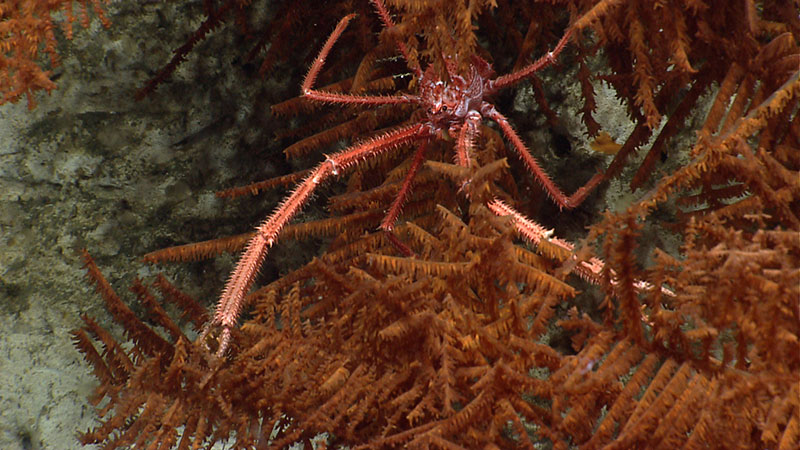The second dive of leg 2 was at a minor canyon near Shallop Canyon. While descending to the bottom, numerous salps and fine marine snow were seen suspended in the water column. The Deep Discoverer remotely operated vehicle (ROV) reached the bottom at a depth of 1,131 meters. The seafloor was mud bottom interspersed with burrows, swimming eels, and squid. The sediment was relatively homogeneous, with no rubble or rocks, which indicates little or no sediment traveled down the canyon to the seafloor. Continuing along the dive track, additional fish were noted and a rubber glove (trash) was partially buried in the sediment. At a depth of 1,118 meters, the ROV came upon a large rock with no debris at the base, a thin sediment coating on the top, and heavy sediment drape at the base. Small octocorals, with only a few polyps, had colonized the rock feature. Their small size suggests recent colonization. At 1,117 meters, the ROV transited to a steep and tall rock face that had weak layering and relatively heavy erosion. At the base of the large rock face, piles of dead stony corals and live bivalves gave the clue that something interesting may be just above. At 1,094 meters, the ROV ascended up the rock feature and imaged many of the rock associates, including hydroids, squat lobsters, various sponges, and many limidae bivalves. While exploring the rock face, several sessile invertebrates were found attached to the wall, in cracks, crevices, and overhangs. Large black corals were particularly numerous on the wall, with several different types of creatures hanging on their branches. The rock wall, potentially Eocene in origin (~56 to 33 million years old), contained numerous holes, which provided a habitat for a polychaete worm, squat lobsters, and encrusting sponges. The ROV reached the top of the feature at 1,031 meters, which was highly sedimented and contained similar fauna and features as the base of wall, including eels and burrows. Once it was clear that the ROV had crossed the steepest feature, there was a ship move to head back to the cliff and continue exploring the wall to the north. At a depth of 1,034 meters, while exploring the wall, several types of sea stars and urchins were seen. The ROV video obtained some amazing footage of several small amphipods perched on a hydroid. The ROV left bottom a bit early because the seas were picking up.
